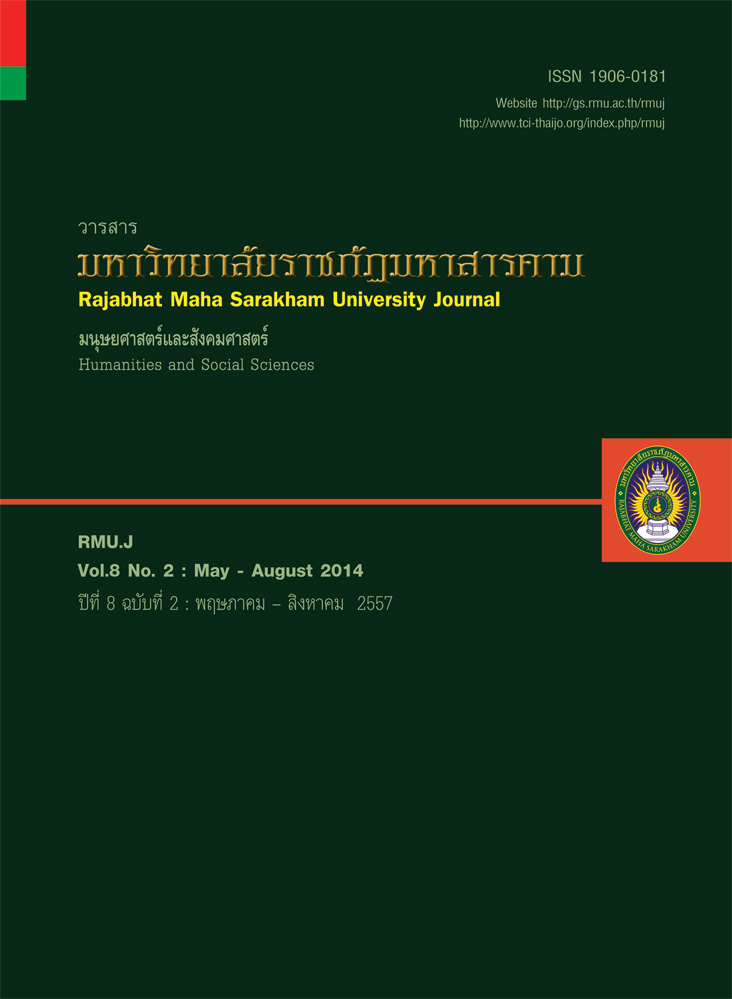กระบวนการเรียนรู้วิทยาศาสตร์ชุมชน เพื่อการพัฒนาท้องถิ่น The Community Scientific Learning Process for Local Development
Main Article Content
บทคัดย่อ
การวิจัยครั้งนี้มีวัตถุประสงค์ ประการแรก เพื่อศึกษาปรากฏการณ์การดำรงชีวิตของคนในชุมชนบ้านเม่นใหญ่ด้วยวิทยาศาสตร์
ชุมชนตั้งแต่อดีตถึงปัจจุบัน ประการที่สอง เพื่อศึกษาการจัดการชุดความรู้วิทยาศาสตร์ชุมชน ที่มีความสอดคล้องและเหมาะสมกับ
คนในชมุ ชนบ้านเมน่ ใหญ ่ ประการทสี่ าม เพอื่ ศกึ ษากระบวนการเรยี นรวู้ ทิ ยาศาสตรช์ มุ ชน เพื่อการพฒั นาทอ้ งถนิ่ และประการทสี่ ี่ เพอื่
ศึกษาผลการใช้กระบวนการเรียนรู้วิทยาศาสตร์ชุมชนเพื่อการพัฒนาท้องถิ่น กลุ่มผู้ให้ข้อมูล คือ กลุ่มบุคคลที่อยู่ในชุมชนและนอก
ชุมชน ประกอบด้วย ผู้นำชุมชนบ้านเม่นใหญ่ ผู้เฒ่าผู้แก่ ที่มีอายุตั้งแต่ 60 ปี ที่มีความรู้เกี่ยวกับวิทยาศาสตร์ชุมชน กลุ่มเป้าหมาย
ประกอบด้วย ภูมิปัญญาท้องถิ่นที่มีชุดความรู้วิทยาศาสตร์ชุมชนเป็นอย่างดี และนักเรียนจำนวน 22 คน ครูที่สอนวิชาวิทยาศาสตร์
ดำเนินการวิจัยแบบผสานวิธี (Mixed methodology) ผลการวิจัยพบว่า
1. ปรากฏการณ์การดำรงชีวิตของคนในชุมชนบ้านเม่นใหญ่ ด้วยวิทยาศาสตร์ชุมชน ตั้งแต่อดีตถึงปัจจุบัน ในอดีตคนในชุมชน
อาศัยทรัพยากรธรรมชาติเป็นหลักในการดำเนินชีวิต ส่งผลให้คนไม่จำเป็นต้องออกจากชุมชน ครอบครัวอยู่พร้อมหน้าพร้อมตา โดย
ร่วมประกอบอาชีพหลักของครอบครัวคือการทำนา มีรายได้ไม่มาก แต่สามารถดำเนินชีวิตอยู่ได้ เพราะคนในชุมชนมีการดำรงชีวิตโดย
อาศัยทรัพยากรธรรมชาติ ปัจจุบันเมื่อความเจริญมาถึง มิติด้านต่าง ๆ ของคนในชุมชน เกิดการเปลี่ยนแปลง จำนวนคนในชุมชนมาก
ขึ้น ทรัพยากรธรรมชาติถูกทำลายส่งผลให้เหลือจำนวนน้อยลง คนเริ่มนำเงินมาเป็นปัจจัยหลักในการดำเนินชีวิต วิถีของคนในชุมชน
ไม่มีการถ่ายทอด ด้านภูมิปัญญาให้รุ่นลูกรุ่นหลาน เข้าถึงการใช้ประโยชน์จากทรัพยากรธรรมชาติที่เหลือเหล่านั้น ขาดการถ่ายทอด
ความรู้ที่จะอยู่อย่างเกื้อกูลกับธรรมชาติ ส่งผลให้นักเรียนในยุคบริโภคนิยม ไม่สามารถดำรงชีวิตบนฐานภูมิสังคมของตนเอง
2. การจัดการชุดความรู้วิทยาศาสตร์ชุมชน ที่มีความสอดคล้องและเหมาะสมกับคนในชุมชนบ้านเม่นใหญ่ ภูมิปัญญาท้องถิ่น
มีจัดการความรู้ โดยการสร้างความรู้ การจัดเก็บความรู้ การถ่ายทอดความรู้และการนำความรู้ไปใช้ สำหรับชุดความรู้ที่มีความเหมาะ
สมมี 3 ชุดความรู้ ได้แก่ ชุดความรู้ในเรื่องอาหาร มีความรู้เรื่อง การถนอมอาหารตามฤดูกาล ชุดความรู้เรื่องการย้อมผ้า มีความรู้
เรื่องการย้อมผ้าจากสีธรรมชาติ และชุดความรู้ เรื่องสมุนไพรในป่าโคกแสบง เรียงลำดับความเหมาะสมจากมากไปหาน้อยตามลำดับ
โดยชุดความรู้เหล่านี้มีการผสมผสานภูมิปัญญา
ท้องถิ่นและความรู้สมัยใหม่เพื่อให้เหมาะสมกับการดำเนินวิถีชีวิตของคนในชุมชนบ้านเม่นใหญ่ ทำให้สามารถพึ่งตนเองได้ภายใต้การ
เกื้อกูลกับทรัพยากรในชุมชนอย่างคุ้มค่า
3. กระบวนการเรียนรู้วิทยาศาสตร์ชุมชน เพื่อการพัฒนาท้องถิ่น มีกระบวนการเรียนรู้ 6 ขั้นตอน คือรู้เหตุ รู้ผล รู้ตน รู้กาล
นำไปประยุกต์ใช้และสร้างภูมิคุ้มกันให้ตนเอง ซึ่งกระบวนการเรียนรู้วิทยาศาสตร์ชุมชนที่สามารถเกิดกระบวนการเรียนรู้เพื่อนำไปสู่ฐาน คิดห้องเรียนของการบริโภคอย่างยั่งยืนมากที่สุด คือกระบวนการเรียนรู้ 6 ขั้นตอนผ่านวิถีการดำรงชีวิตแบบไทย และกระบวนการเรียน
รู้ผ่านวัฒนธรรม ประเพณี ตามลำดับ
4. ผลการใช้กระบวนการเรียนรู้วิทยาศาสตร์ชุมชน เพื่อการพัฒนาท้องถิ่น พบว่า พฤติกรรมนักเรียนด้านกระบวนการเรียนรู้
วิทยาศาสตรช์ ุมชนทั้ง 3 กิจกรรม อยใู่ นระดับมากที่สุด (คา่ เฉลี่ย 4.50) ความพึงพอใจนักเรียนในกระบวนการเรียนรวูิ้ทยาศาสตรช์ มุ ชน
อยู่ในระดับมากที่สุด (ค่าเฉลี่ย 4.57) และการใช้กระบวนการเรียนรู้วิทยาศาสตร์ เพื่อพัฒนาท้องถิ่นอยู่ในระดับมากที่สุด (ค่าเฉลี่ย
4.58) นอกจากนี้เกิดการพัฒนาคนในชุมชนในมิติต่าง ๆ คือ มิติด้านการศึกษา มิติด้านสิ่งแวดล้อม มิติด้านสังคม และมิติด้านเศรษฐกิจ
เกิดการขับเคลื่อนองค์กรรูปแบบกระบวนการเรียนรู้วิทยาศาสตร์ชุมชน ในพื้นที่ใหม่ชื่อว่า พิพิธภัณฑ์มีชีวิต “วิทยาศาสตร์ชุมชน”
ที่สามารถเป็นแหล่งเรียนรู้ให้กับกลุ่มต้นกล้าในชุมชนและนอกชุมชน ที่จะถักถอกระบวนการเรียนรู้ เพื่อให้เข้าถึงและใช้ทรัพยากรที่มี
ในชุมชนของตนเองให้เกิดประโยชน์สามารถพึ่งตนเองได้ เกิดเครือข่ายวิทยาศาสตร์ชุมชน
The purposes of the research were to: 1) explore living conditions of people in Men Yai Village by using
community science from the past up to present; 2) investigate knowledge management of community science
based on the needs and appropriateness of people in Men Yai village; 3) study learning process of community
science for local development; and 4) study results of community science learning process. The informants
consisted of community leaders and villagers over 60 years old with community science knowledge. The
target group consisted of local experts in community science, science teachers and 22 students. The research
was conducted through mixed methods. The research results were as follows:
1. Living conditions of people in Men Yai community from the pat up to present was mainly based on
natural resources. As a result, the people in community lived closely with nature. Most of the villagers were
farmers who did not earn much money from rice production; however, they were able to live in community
happily because their living conditions depended on natural resources which were available in community.
Nowadays the community has been changed into different dimensions. There were a large number of people
in community. Natural resources were destroyed. Money became the important factor in daily life. Local
wisdom was not transferred to new generation in community to recognize the benefits of natural resources
and they did not use the resources efficiently for their life. There was no knowledge transfer to the students
to live with nature that made the students in consumerism unable to live in their own society or community.
2. knowledge management of community science based on the needs and appropriateness of people
in Men Yai village Knowledge management of community science related closely to the needs and
appropriateness of people in Men Yai community. Local wisdom has been managed by building, storing,
transferring, and implementing knowledge. There were 3 appropriate local wisdom packages, including
package of food which comprised knowledge of food preservation, package of cloth dye which comprised
knowledge of using natural color for cloth dye, and package of herb in Khoksabaeng Village. These three
knowledge packages were integrated with local wisdom and modern knowledge for being appropriate to
their living conditions of people in Men Yai community. As a result, they were able to live by self with natural resources in the community.
3. The community science learning process for local development consisted of 6 steps: identifying
problems, finding solution, self-recognition, time recognition, application and building self protection.
Community science learning process that led to sustainable consumption comprised 6 steps of learning
process through Thai traditional life style, culture and tradition, respectively.
4. The results of community science learning process for local development showed that the students’
behaviors towards community science learning process with 3 learning packages were at a highest level. The
students’ satisfaction towards community science learning process was at a highest level, and the students’
satisfaction towards use of science learning process for community development was at a highest level. People
in community were developed in many dimensions: education, environment, society and economy. Community
science learning process was appeared with the new name as “Living Museum-Community Science” that can
be used as learning center for students and initiators in and outside the community to access and use natural
resources in the community, and then appeared the community science learning networks.
Article Details
1. บทความที่ลงตีพิมพ์ทุกเรื่องได้รับการตรวจทางวิชาการโดยผู้ประเมินอิสระ ผู้ทรงคุณวุฒิ (Peer Review) สาขาที่เกี่ยวข้อง อย่างน้อย 3 ท่าน ในรูปแบบ Double blind review
2. ข้อคิดเห็นใด ๆ ของบทความที่ลงตีพิมพ์ในวารสารมหาวิทยาลัยราชภัฏมหาสารคาม นี้เป็นของผู้เขียน คณะผู้จัดทำวารสารไม่จำเป็นต้องเห็นด้วย
3. กองบรรณาธิการวารสารมหาวิทยาลัยราชภัฏมหาสารคาม ไม่สงวนสิทธิ์การคัดลอกแต่ให้อ้างอิงแสดงที่มา


